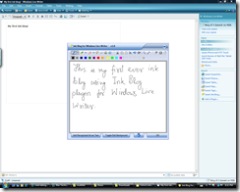Ever since the release of the much delayed OS from Microsoft, it never seems to be on the correct side of the news reported world around. I beg to differ and through this post I would like to tell my experience of using Windows Vista for more than 8 months now.
Setup that I use daily
I do most of my work on GNU/ Linux. At work, all my machines (development, clusters and word processing) use either Fedora 8 or Ubuntu 7.10. For home and personal use I have two old desktop machines, one new DELL machine (preloaded with Windows Vista Ultimate edition) and two ultra mobiles: Mobilis (reviewed here) and HCL MiLeap -L (reviewed here). Of the two desktop machines one is fairly new and has Fedora 6 loaded on it. The other is about 8 years old and came preloaded with Windows 98 (HP Pavilion 6615).
Of all the machines at home, I have been using the Fedora 6 machine for all my day-today activities till I got the DELL machine. Now I use the Fedora 6 machine mostly for programming and rarely for watching DVDs. When I am on move or bored sitting in front of my desktops I use my ultra mobiles.
Well to be very complete I also own a Nokia 6600, but use it rarely ever since I got the two ultra portables.
In terms of expenses I did for my personal set up, the Windows machines were about 8 times as expensive! That's because my Linux machine was a second hand buy (but of COMPAQ evo brand).
Finally no hurting the feelings of Mac people but I never owned a Mac and probably will never because I always have a feeling that they are too closed source people even if their base kernel and development tools are all GNU based.
Vista: An OS that serves me and my parents well
Let us first see the things in the perspective of my parents. They always need a way to communicate using the Internet and easily access many stuffs like photos, videos, watch movies and many a times catchup with the TV shows. Being a media centre computer with Windows Media centre installed, they find the machine relatively easy to use. They also find using IE7 easy (I don't have FireFox installed currently). GTalk and Skype are other applications they use and are relatively mature on Windows than other OS. As far as advanced features of Vista are concerned I do not believe that they are directly useful for them. But features like "sleep" are better implemented in Vista than in XP, in the later case I had constantly observed freezes of my machine. On Vista however this problem seems to have disappeared all together. Another feature my parents had to frequently deal with earlier version of Windows was the "blue screen of death", I have not encountered a single instance of this on my Vista machine to date, despite a number of hardware changes that I did over the original setup.
The Instant Search and the inbuilt voice recognition tools are also frequently used and most loved tools (especially by me). For me the Instant Search is in many ways better than other similar tools provided on other OSes. The voice recognition on the other hand seems to be an unique feature in Vista.
Going into more technicality, my basic needs from an OS are: Good development tools, rich media and Internet experience, devices should just work, be secure to a large extent, and an intuitive user experience. Before using Vista I have used all previous versions of Windows form Windows 3.1. I have also regularly used Linux distributions from Red Hat 6 to Caldera to SusE, PC Quest and Ubuntu (from 6.10). It has always been hard to figure out how to get a particular device work under Linux; which has never been the case with Windows. People would argue that this problem is mainly for devices or peripherals who do not open up their proprietary hardware to Linux developers. This may be partially true, but when I look from a users perspective it comes to choosing between one of the "better" OS, the one on which devices just work. Further, installation of a driver under Linux can simply be not done by an average computer user. You should have fair amount of idea of what a kernel is and what a compiler is, which my parents simply can't cope with! well all that for support of Windows:) But what makes Vista stand out from previous version of Windows is a feature in the Windows update that automatically comes back to you incase no appropriate drivers are found (which I myself experienced with Logitech Quickcam webcam).
Vista also comes with a assortment of development tools, many of which can be downloaded for free from Microsoft's site. Many of the tools can be used to build applications for older version of Windows too. The tools provided with Visual Studio Express edition are just enough for my work. Though I have also installed the Windows SDK as some of the programs I compile require core Win32 libraries.
I regularly use Virtual PC 2007 and VirtualBox for virtualization environment and find both of these to work without any hitch on my Vista machine. I frequently need Linux environment to test a lot of stuff so I have installed Ubuntu with all required compilers in VirtualBox and find its performance under Vista (even when running media center and recording the current TV show) very smooth.
UAC of Vista had been a big topic of debate, but I find it to be pretty usable and worth the hassle. Moreover, it is how it works out in the Linux world (sudo!).
Some things are a problem though
I have been wanting to program with the CUDA system from NVidia since a long time, but its drivers for Vista have simply not been available to date :(
Finally
In short, after more 8 months of using Vista, I find it to be a fantastic and rock solid product, which makes it worth to invest in a bit of new hardware too.
NB: This full review was written with Windows Live Writer using the iBall pen tablet ( reviewed here).
This review is not endorsed by Microsoft and are my personal views.















.jpg)















